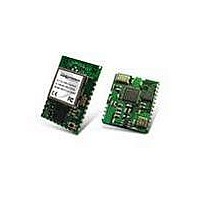WI.232FHSS-250-R Radiotronix, WI.232FHSS-250-R Datasheet - Page 17

WI.232FHSS-250-R
Manufacturer Part Number
WI.232FHSS-250-R
Description
RF Modules & Development Tools 900MHz FHSS Low
Manufacturer
Radiotronix
Datasheet
1.WI.232FHSS-25-FCC-RA-R.pdf
(67 pages)
Specifications of WI.232FHSS-250-R
Lead Free Status / RoHS Status
Lead free / RoHS Compliant
Other names
WI232FHSS-250-R
WI.232FHSS-25-R/ WI.232FHSS-250-R DATASHEET
Table 3, User Addressing Examples
2.4.3. Extended User Addressing Mode
When Extended User Network mode is selected, transmitted packets locate endpoints using the customer ID
and destination User ID (specified in
packet sent with Extended User Network mode enabled carries 20 bytes of overhead. On the receiving side,
each module has a User ID mask (regUSERIDMASK[3-0]) that it applies to both its own User ID
(regUSERSRCID[3-0]) and the incoming destination User ID. Once both are masked, if the results are
equal, the receiving module will pass the payload data to the application for presentation to the host.
Additionally, if the incoming address, once masked, equals the mask itself, its payload will be presented to
the host. If an acknowledgement is requested, the receiving module will respond only if the unmasked User
IDs are equal. When using extended user network mode to send packets to multiple users (mask not equal
to 0xFFFFFFFF), assured delivery must be disabled. Failure to do so could cause extreme delays in
transmission and loss of data. The following table shows some examples of extended user addressing at
work.
Table 4, Extended User Addressing Examples
2.4.4. Assured Delivery (Acknowledgement)
While not an addressing mode on its own, assured delivery can be enabled for each of the above addressing
modes. When a module transmits with assured delivery enabled, it obligates the receiving module to return
an acknowledgement packet. The transmitting module will wait for this acknowledgement for a preset
amount of time based on the data rate. If acknowledgement is not received, it will retransmit the current
packet. If the receiver receives more than one of the same packet, it will discard the packet contents but
send an acknowledgment. This way, duplicate data is not presented to the receiver’s UART. It is extremely
important that assured delivery be used only when the unmasked user/extended user Destination ID or
Destination GUID points to a specific module. Failure to specifically address a valid endpoint could cause the
module to appear slow or unresponsive due to repeated retransmissions. This will also serve to congest the
0x06
Sender
Network
Mode
0x07
0x17
0x17
0x07
User SRCID
0x10000000
0x10000000
0x10000000
0x10000000
0x1000
0x3000
User DESTID
0xFFFFFFFF
0xFFFFFFFF
0x30000001
0x30000002
regCUSTID[1-0]
0x3000
0x2000
0x3000
Receiver
User SRCID
0x20000001
0x20000002
0x20000001
0x20000002
0x20000001
0x30000001
0x20000001
0x30000001
16
and regUSERDESTID[3-0], respectively). An RF
0xE000
0xF000
0xF000
User
IDMASK
0xFFFFFFFF
0xFFFFFFFF
0xFFFFFFFF
0xFFFFFFFF
0xE0000000
0xE0000000
0xF0000000
0xF0000000
Data sent to UART. RF ACK sent
to 0x1000 by GUID.
Not processed- discarded.
Data sent to UART. No RF ACK
sent.
Response
Data sent to UART. No RF
ACK sent by either module.
Data sent to UART in both
modules. No ACK sent by
either module. This
configuration will cause
transmission problems.
Data sent to UART. No RF
ACK sent.
Data sent to UART. RF ACK
sent to 0x10000000 by GUID.
Not processed- discarded.
Data sent to UART. No RF
ACK sent.
Revision 1.1.0













